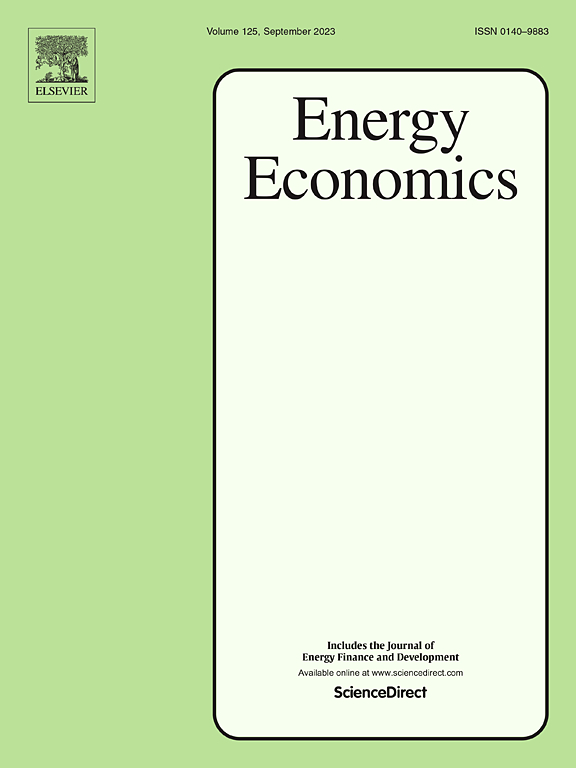Temperature-related energy insecurity and heating degree thresholds for prepayment gas customers in England and Wales
IF 13.6
2区 经济学
Q1 ECONOMICS
引用次数: 0
Abstract
Extreme temperatures can be dangerous when increased energy use for heating or cooling leads to household energy insecurity events, such as de-energisation or self-rationing. Prepayment (or pay-as-you-go) for electricity and/or gas is used in over 30 countries, but few studies quantify the actual incidence and rate of temperature-related energy disconnections. This study uses smart-meter data for over 600,000 prepayment gas customers in England and Wales across more than 7 winters to understand how cold weather impacts credit top up behaviour, emergency credit borrowing, and running out of credit, which leads to self-disconnection. The impact of cold temperatures on credit top-ups is greatest below heating degree thresholds of −3.8 °C, −5.6 °C and − 5.1 °C for those living in regions with high fuel poverty, North England and Yorkshire, and regions with low wages, respectively. For self-disconnection events, similar thresholds are found. High rates of temperature-related self-disconnection also occur in regions with high claimants of unemployment related benefits. An analysis of credit top-up amounts shows that most top ups are £20 or less but for cold events below −6 °C there is a significant increase in top-ups above £20. People also anticipate cold events with minimum temperatures below −3 °C and − 5 °C but do not react in the same way to the metric used to trigger the Cold Weather Payment. Revising the Cold Weather Payment with a daily minimum temperature trigger may help people anticipate payment and avoid self-rationing.英格兰和威尔士预付费燃气客户的温度相关能源不安全和供暖度阈值
当用于供暖或制冷的能源使用量增加导致家庭能源不安全事件(如断电或自我配给)时,极端温度可能是危险的。30多个国家采用预付(或现收现付)电费和/或燃气费,但很少有研究量化与温度有关的能源中断的实际发生率和比率。这项研究使用智能电表数据,分析了英格兰和威尔士超过60万名预付天然气客户在7个多冬天的情况,以了解寒冷天气如何影响信用充值行为、紧急信用借款以及信用耗尽,从而导致自我中断。对于生活在燃料高度贫困地区、北英格兰和约克郡以及低工资地区的人来说,低温对信贷充值的影响最大,分别低于加热度阈值- 3.8 °C、- 5.6 °C和 - 5.1 °C。对于自断开事件,发现了类似的阈值。与温度相关的自我断网率高也发生在失业相关福利申领人数较多的地区。对信用充值金额的分析表明,大多数充值金额为20英镑或更少,但对于低于- 6 °C的寒冷事件,充值金额高于20英镑的金额显着增加。人们还预计最低温度低于- 3 °C和 - - 5 °C的寒冷事件,但不会以相同的方式对触发寒冷天气付款的指标做出反应。修改寒冷天气补贴,增加每日最低温度触发可能有助于人们提前付款,避免自我配给。
本文章由计算机程序翻译,如有差异,请以英文原文为准。
求助全文
约1分钟内获得全文
求助全文
来源期刊

Energy Economics
ECONOMICS-
CiteScore
18.60
自引率
12.50%
发文量
524
期刊介绍:
Energy Economics is a field journal that focuses on energy economics and energy finance. It covers various themes including the exploitation, conversion, and use of energy, markets for energy commodities and derivatives, regulation and taxation, forecasting, environment and climate, international trade, development, and monetary policy. The journal welcomes contributions that utilize diverse methods such as experiments, surveys, econometrics, decomposition, simulation models, equilibrium models, optimization models, and analytical models. It publishes a combination of papers employing different methods to explore a wide range of topics. The journal's replication policy encourages the submission of replication studies, wherein researchers reproduce and extend the key results of original studies while explaining any differences. Energy Economics is indexed and abstracted in several databases including Environmental Abstracts, Fuel and Energy Abstracts, Social Sciences Citation Index, GEOBASE, Social & Behavioral Sciences, Journal of Economic Literature, INSPEC, and more.
 求助内容:
求助内容: 应助结果提醒方式:
应助结果提醒方式:


